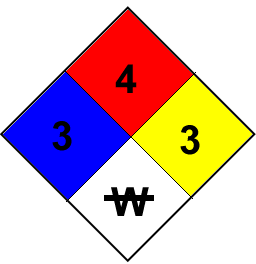A typical sign that you're talking about might look like this:
You see these signs on any building that contains hazardous chemicals. The sign is called an NFPA panel. NFPA stands for National Fire Protection Association.
Advertisement
The idea behind these signs is to give firefighters some sort of advanced notice on what they are getting themselves into when they arrive at the scene of a fire. When there is a house fire, firefighters have a pretty good idea of what they are in for, but if there is a fire at a warehouse in an industrial park, it is very hard to know what chemicals might be stored there. The NFPA panel is a clear indication of what sort of dangers might lie inside.
The panel has four areas:
- Red - Fire hazard
- Blue - Health hazard
- Yellow - Reactivity
- White - Specific hazard
The numbers in the first three areas range from 0 to 4, with 0 signifying no hazard and 4 signifying a severe hazard. For example, in the Reactivity area:
- 0 = Stable
- 1 = Unstable if heated
- 2 = Violent chemical
- 3 = Shock or heat may detonate
- 4 = May detonate
In the Fire hazard area, the numbers indicate the flash point:
- 0 = Will not burn
- 1 = Above 200 degrees F (93 C)
- 2 = Below 200 degrees F
- 3 = Below 100 degrees F (38 C)
- 4 = Below 73 degrees F (23)
Concrete is an example of a class 0 fire hazard. Paper and wood are class 1.
In the Health hazard area:
- 0 = No hazard
- 1 = Slightly hazardous
- 2 = Hazardous
- 3 = Extremely hazardous
- 4 = Deadly
In the Specific hazard area, you will see things like:
- OXY - Oxidizer
- ACID
- ALK - Alkali
- COR - Corrosive
You may also see a "W" with a bar through it (meaning "use no water"), or the radiation hazard symbol for radioactive materials.
Now you can drive around your neighborhood and get a glimpse into what is stored in all of the buildings!
These links will help you learn more:
Advertisement
